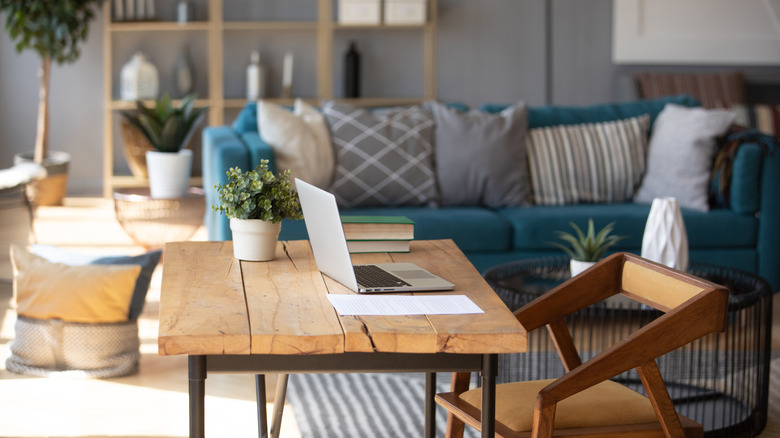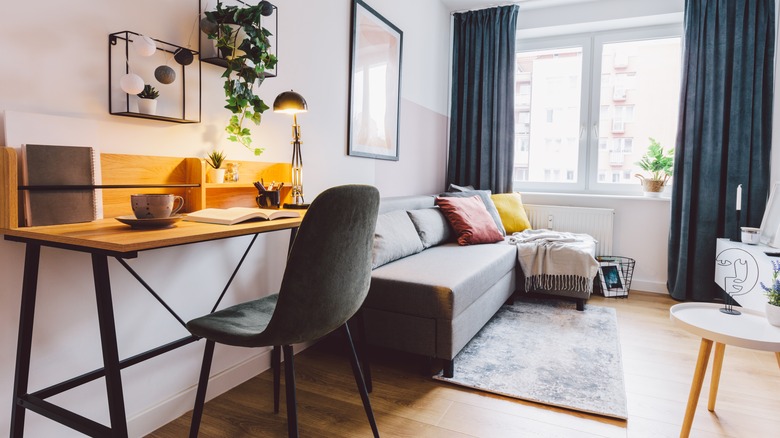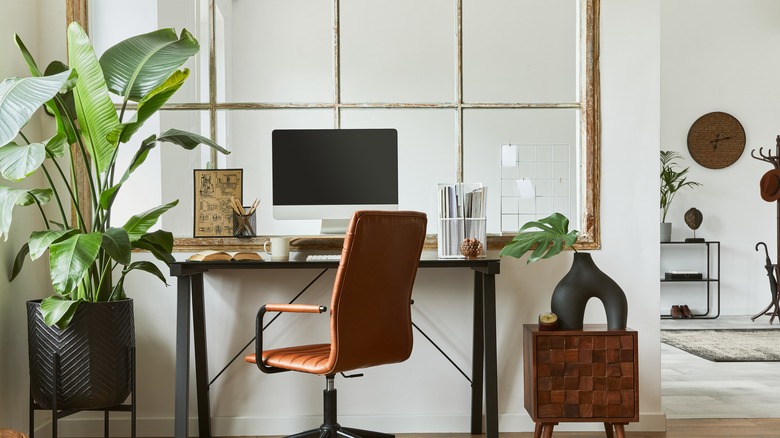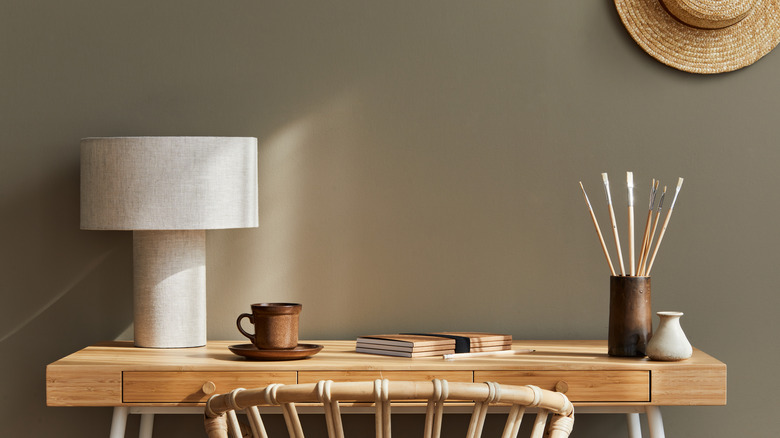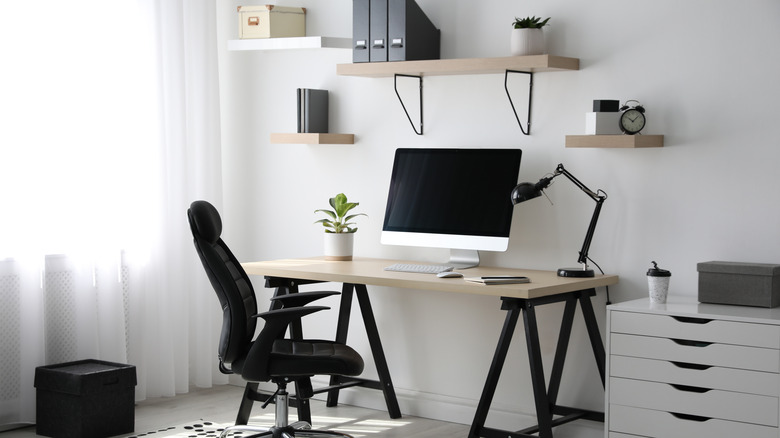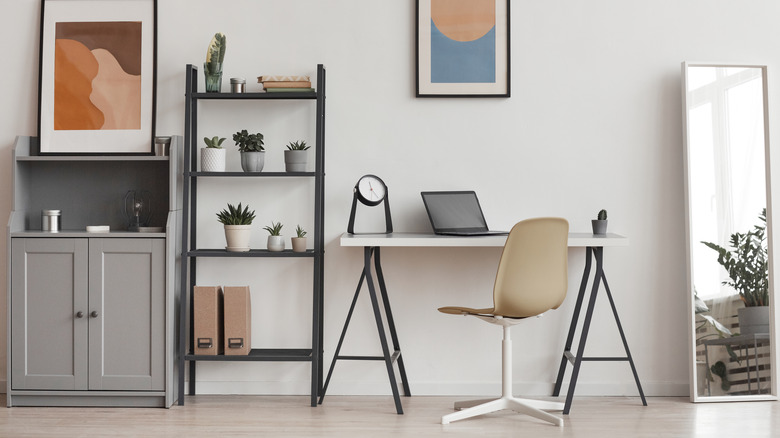How To Incorporate A Home Office Into Your Living Room
While a perfectly appointed stand-alone home office is on everyone's wish list, it's not always possible, particularly when living in smaller spaces. With a vast work-from-home experience under our belts now, many have made both intentional and ad-hoc workstations work for them, be it a corner of a living room or bedroom or a cozy spot at the dining or kitchen table.
Living rooms, where we spend a large amount of time, are an excellent option for a home workspace setup without an additional dedicated area. As usually the largest room in the house, there is a bit more space to spread out and create a functional and attractive office setup, even if it's just a corner or cubby. And even if you do not work from home every day, a desk setup is often a great way to fill space and offer a flexible option for small activities like bill paying, email writing, and journaling that require a work surface and comfortable chair. Per Designing Idea, there are a number of things to keep in mind when incorporating a new office space within an existing living room, including considerations of function, usability, comfort, and style.
Have a work surface
Your first consideration should be finding the perfect work surface. A desk or table catered to what you'll be working on and how you work is essential, providing ample space for laptops/PCs, paperwork, or other things you need access to. While conventional desks may be what we think of first, there are also other stylish options, including narrow tables, consoles, and vanities that shake things up a bit. Several retailers also feature fold-away desk surfaces that disappear into a cabinet or armoire when not in use or that can be folded down against the wall on hinges to not take up space the rest of the time.
According to Life Hacker, there are several things to consider when choosing the perfect desk, including ergonomic needs like height and surface size. If most of your work occurs on a laptop and doesn't require a lot of space, opt for a slimmer, smaller work desk that will resist the urge to become too cluttered. If your work involves a lot of paperwork or supplies, opt for a surface large enough to spread out or with shelving above to give more room. A small but functional desk that matches other elements in the room offers a rack to store books, tablets, and laptops as well as a small shelf for décor or supplies.
Get the perfect chair
Gone are the days of sitting hunched over your laptop at the coffee table. Instead, a living room office setup demands a comfortable, useful chair to enjoy your workspace. The best ones also double as additional seating for guests the rest of the time, so choosing something that is comfortable and attractive is equally important. According to Creative Bloq, when selecting a new chair, you should consider usage, adjustability, cost, and comfort questions. While many more ergonomic options leave a lot to be desired in terms of looks, many retailers feature stylish and beautiful pieces that are as comfortable as your standard office-issue seat.
Look for chairs that come in complementary finishes to the rest of your décor, be it leather, woven fabrics, or even velvet. Many offer adjustments in height, wheels, and comfortable support that rival the best in more generic office chairs. If you spend a shorter time at your desk set-up, other kinds of chairs may work for you, including straight-back ones, club chairs, or cute stools. If you're going for a mid-century look, vintage vinyl propeller-style pieces are incredibly durable and comfortable for hours while looking incredibly stylish.
Proper lighting is important
Good lighting is a must, particularly a well-appointed task-oriented option that doesn't make working for hours (especially in the dark of winter), a burden. While the temptation may be to go for the standard long-armed desk lamp and a single bright bulb, you may find there are more stylish alternatives that fit more coherently into your décor, like table lamps, overhead pendants, or floor lamps (via Lamps Point).
A sculptural, modern lamp not only provides necessary illumination for working but doubles as a beautiful accent piece in the living room, casting a more subdued amount of light than a bright desk lamp would. Having a number of different lighting options in your living room makes working comfortable and combats strained eyes. Your setup can also be augmented by other illumination efforts like small reading clip-on lamps and light-up keyboards where needed. Having an option for strong overhead lighting, even if it is not always on, can also be helpful for more detailed work.
Technology needs
Since so much of our work is often wrapped up in technology, any well-appointed office space within the living room should have everything you need in terms of electronics, including a monitor, a mouse, a charging station, or a home printer. While cords and computers are sometimes less attractive, there are several ways to incorporate these things without feeling like your work area is cluttered with gadgets and cords.
Many contemporary desks have hidden ports for electronics and sly ways of hiding cords. If you don't have these, a lot can be accomplished with well-placed binder clips (via Staples) to bunch and secure wires and cables to be tucked out of sight. Consider placing objects like routers and modems inside baskets, allowing airflow and signals to move freely but keeping them out of sight. Printers and other desktop necessities can be ticked in cabinets and covered when not in use.
Storage and organization
Storage and organization are essential for a functional workspace, no matter what kind of work you do there. While many desks feature an array of drawers and cubbies, sometimes you need a little extra help in the form of shelving or cabinets. A small hutch can double as a cabinet for hidden storage, while a ladder bookshelf can hold books, plants, and file organizers. The effect is still intentional and organized without looking too busy or overwhelming. According to ExtraSpace Storage, good organization principles keep the office area from being cluttered and taking over the entire room.
If your work requires a lot of stuff, a sideboard or bureau might be the perfect thing to hide away supplies or files. Armoires are great additions to working areas, providing not only closed-door cabinet storage, but can be outfitted with cork on the inside for a hidden reminder and inspo board. Low cabinets can also provide additional work surfaces, while shelves can house everything from smaller drawer-packed organizers to décor items.
